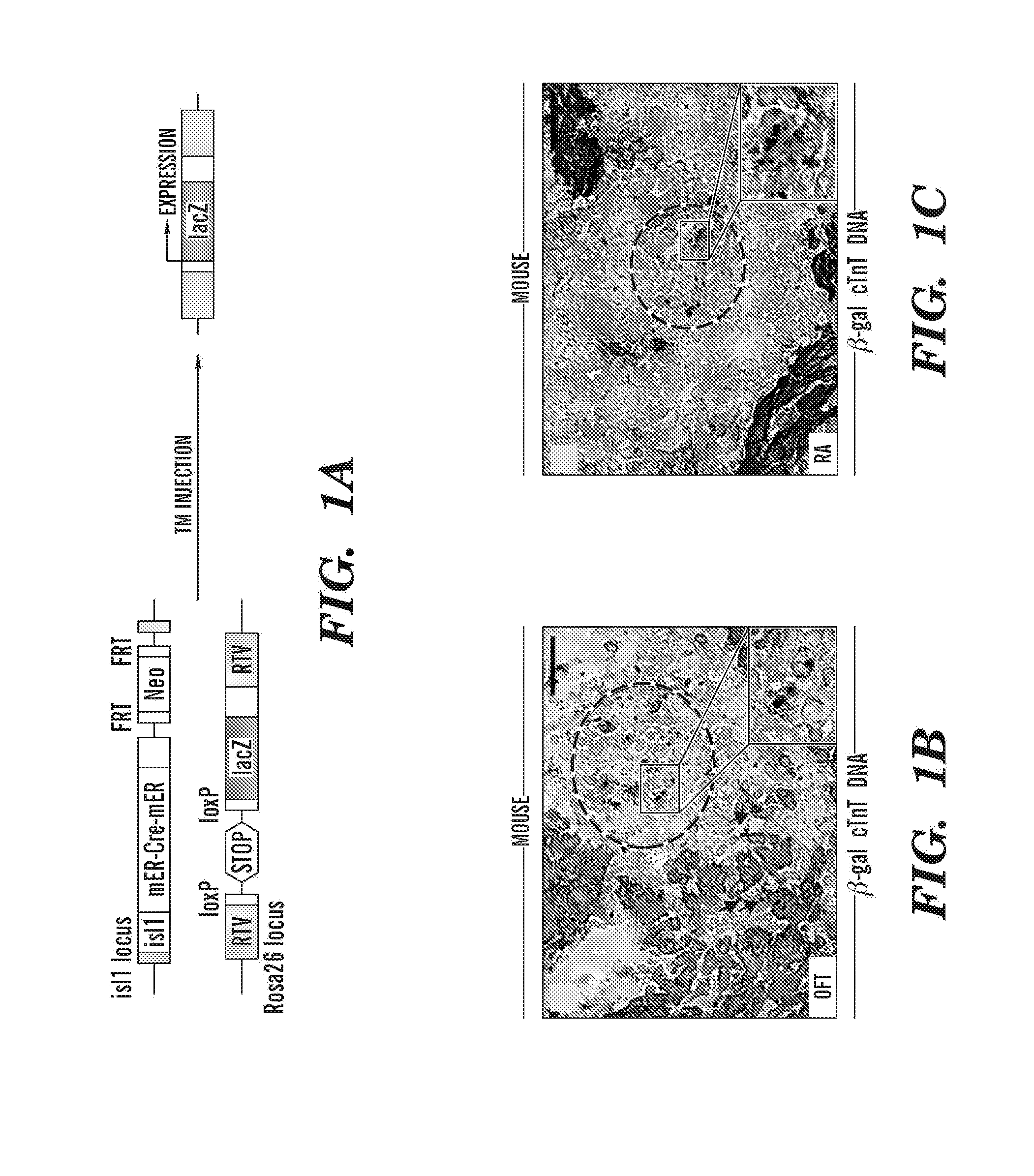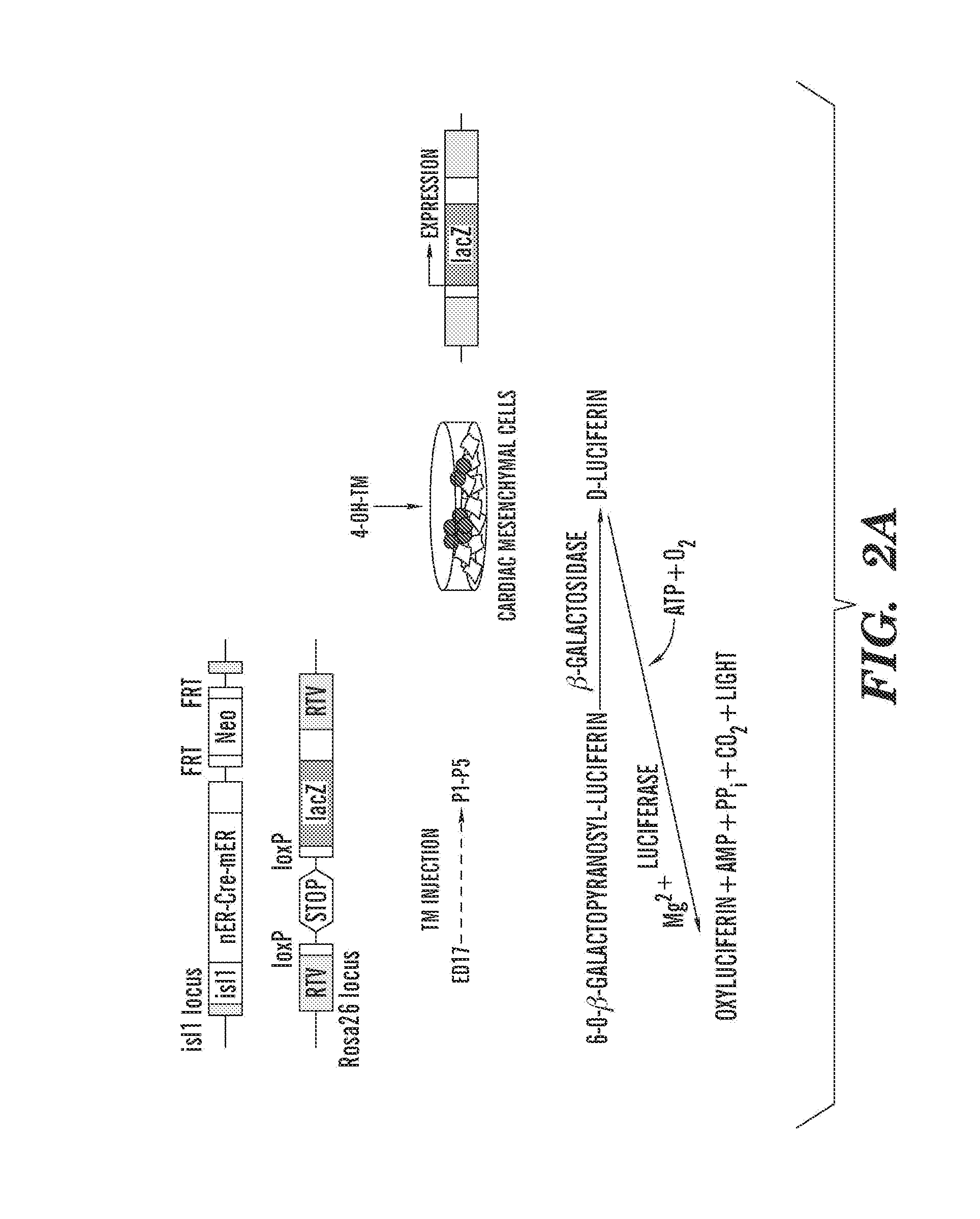Methods for the induction of a cell to enter the islet 1+ lineage and a method for the expansion thereof
a cell and islet technology, applied in the field of induction of a cell to enter the islet 1 + lineage and a method for the expansion thereof, can solve the problems of inability to markedly enhance the in vitro cardiogenesis process, the difficulty of marked expansion of well-defined clonal cardiovascular progenitor cell populations, etc., to achieve enhanced expansion of isl1+ progenitors, enhance wnt signaling, and maintain the capacity for multi-lineage differentiation
- Summary
- Abstract
- Description
- Claims
- Application Information
AI Technical Summary
Benefits of technology
Problems solved by technology
Method used
Image
Examples
example 1
[0257]Neonatal Isl1+ Cardiovascular Progenitors Are Preferentially Localized in an In vivo Microenvironment of Cardiac Mesenchymal Cells in the Non-myocyte Compartment. Isl1+ cardiac progenitors have recently been identified from rat, mouse and human myocardium with the potential to differentiate into mature atrial and ventricular myocytes (Laugwitz et al., 2005). However, their number decreases progressively after the formation of the heart from embryonic day 12.5 (ED12.5) to adulthood (Laugwitz et al., 2005). As the micro-environmental niche plays a paramount role in stem cell / progenitor maintenance (Scadden, 2006), the inventors analyzed the in vivo microenvironment of isl1+ cardiovascular progenitors and the molecular cues that control their formation, renewal, and differentiation that emanates from this microenvironment.
[0258]To genetically mark isl1+ progenitors in the postnatal heart, the inventors crossed isl1-mER-Cre-mER mice, which express a tamoxifen-inducible Cre recombi...
example 2
[0260]High-Throughput Screening Identifies Chemical Probes that Enhance CMC Cues for Expansion of Isl1+ Cardiac Progenitors. To find cardiac mesenchymal cells (CMC)-derived environmental cues involved in the renewal of isl1+ progenitors, the inventors developed a high-throughput chemical screening system, based on the coculture of CMC with postnatal isl1+ progenitors (FIG. 2A). To genetically mark isl1+ progenitors in the postnatal heart, the inventors crossed isl1-mER-Cre-mER (MCM) mice with the conditional Cre reporter strain R26R (Laugwitz et al., 2005; Soriano, 1999), as shown in FIG. 2A. Recently, several synthetic small molecules from a combinatorial library of heterocyclic compounds were identified that regulate stem cell fate (Ding et al., 2003; Wu et al., 2004). The inventors used this library to screen for small molecules that would expand the rare population of postnatal isl1+ progenitors.
[0261]Cardiac mesenchymal cells (CMC) from isl1-MCM / R26R mouse hearts were isolated ...
example 3
[0266]Wnt / β-Catenin Pathway Plays a Pivotal Role in the Control of Isl1+ Progenitor Expansion. The above results demonstrated that CMC-derived cues promote the expansion of isl1+ progenitors through the inhibition of GSK-3 activity, leading the inventors to investigate the roles of signaling molecules in the GSK-3 pathway (Dominguez and Green, 2001). The inventors examined whether Wnt3a, a well-established ligand in the Wnt / β-catenin pathway (Logan and Nusse, 2004), was able to expand postnatal isl1+ progenitors. Treatment with Wnt3a-conditioned medium resulted in a 2-fold increase of isl1+ progenitors compared with the control (FIG. 3A, p+ cell clusters (FIG. 3B, p+ progenitors versus control (FIG. 3C, p+ cell clusters (FIG. 3D, p<0.001).
[0267]Cumulatively, the inventors have discovered that canonical Wnt-GSK3 signalling plays an important role in the expansion of isl1+ progenitors driven by CMC environment-derived cues. The inventors next performed, in isl1+ progenitors, in situ a...
PUM
| Property | Measurement | Unit |
|---|---|---|
| density | aaaaa | aaaaa |
| pH | aaaaa | aaaaa |
| pH | aaaaa | aaaaa |
Abstract
Description
Claims
Application Information
 Login to View More
Login to View More - R&D
- Intellectual Property
- Life Sciences
- Materials
- Tech Scout
- Unparalleled Data Quality
- Higher Quality Content
- 60% Fewer Hallucinations
Browse by: Latest US Patents, China's latest patents, Technical Efficacy Thesaurus, Application Domain, Technology Topic, Popular Technical Reports.
© 2025 PatSnap. All rights reserved.Legal|Privacy policy|Modern Slavery Act Transparency Statement|Sitemap|About US| Contact US: help@patsnap.com



